MSI GT70 Dragon Edition Notebook Review: Haswell and the GTX 780M
by Dustin Sklavos on June 18, 2013 12:01 AM ESTSystem Performance
The new benchmark suite has left us in a bit of disarray, but thankfully we did have the CyberPowerPC Fangbook in recently. The Fangbook sports an Ivy Bridge CPU with exactly the same clocks as the i7-4700MQ powering the MSI GT70 Dragon Edition, and that gives us an excellent baseline for comparison.
I'd also like to personally thank NVIDIA for furnishing us with an Alienware M17x R4 equipped with a GTX 680M at the eleventh hour so we can get proper comparative results. Unfortunately, as you'll see the 780M in the GT70 Dragon Edition gets hamstrung by the CPU (more on this later) when tested playing games that hit the GPU and the CPU especially hard.
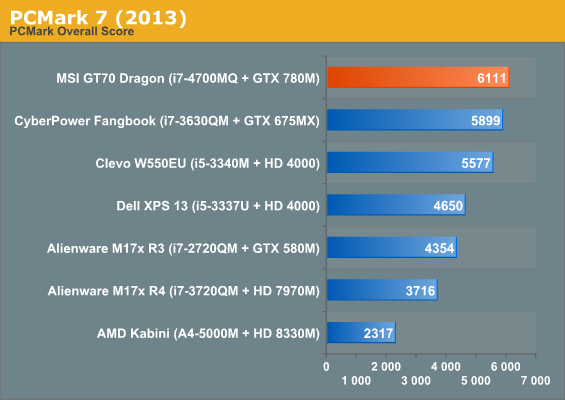
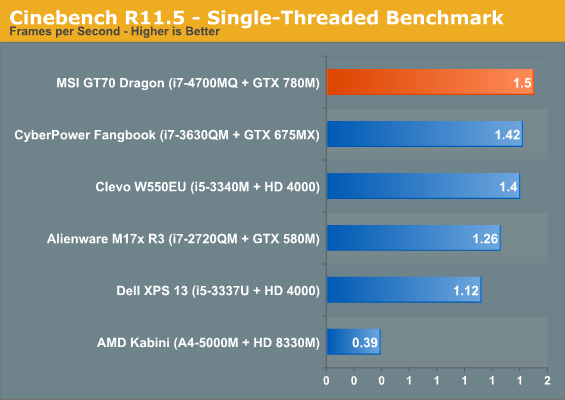
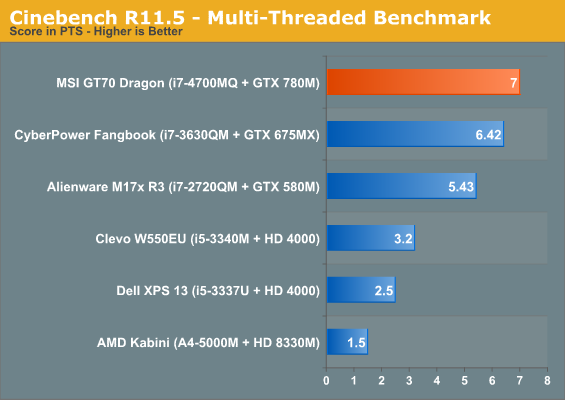
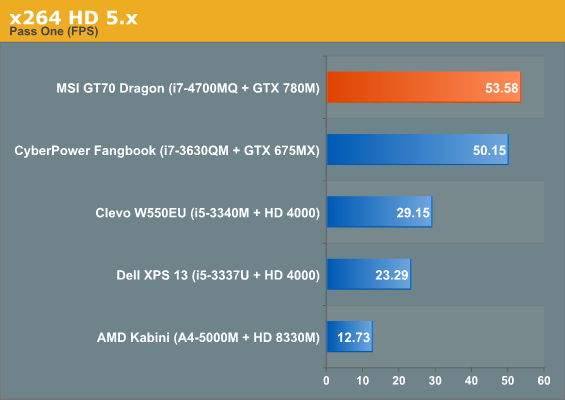
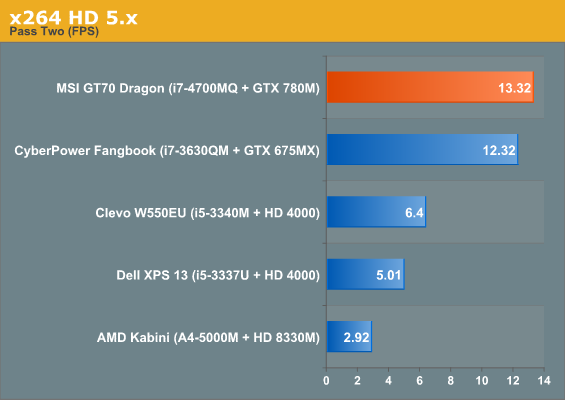
Haswell is certainly faster clock for clock, but obviously owners of Ivy Bridge-based notebooks shouldn't be chucking their old kit. Under most circumstances, the i7-4700MQ is less than 10% faster than the i7-3630QM.
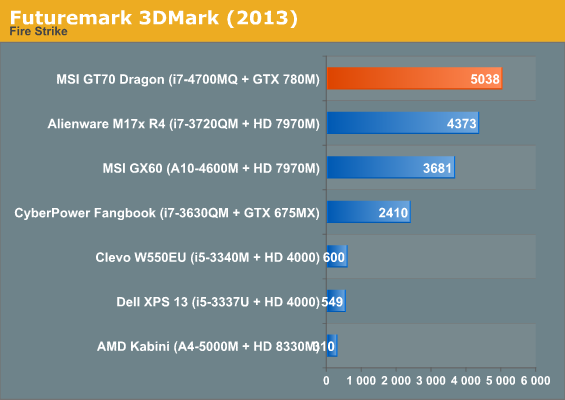
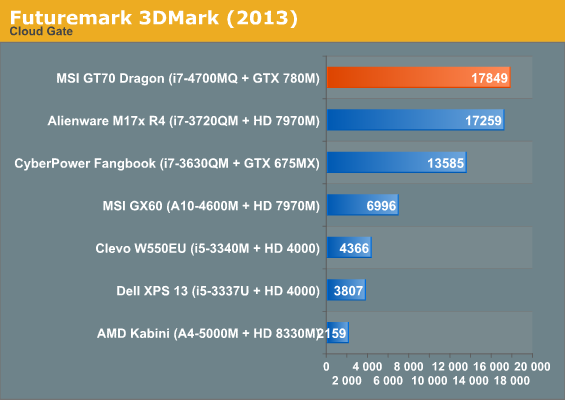
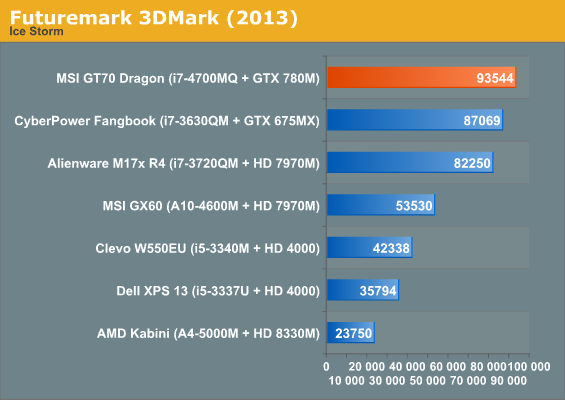
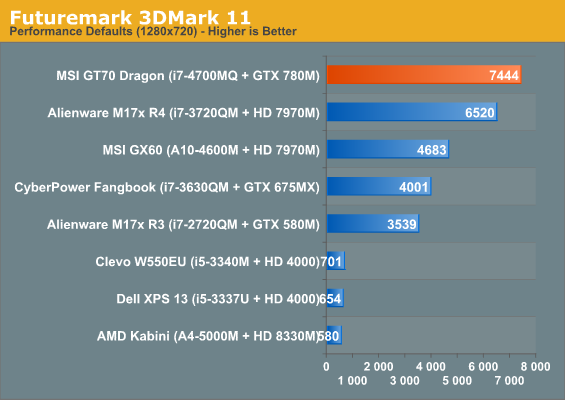
Pop on over to the 3DMarks and the 780M looks good, but unusually, not quite as good as it ought to. It has a commanding lead over the GTX 580M, and it should, but on Cloud Gate and Ice Storm it should also be blowing right past the 7970M. You'll get a better idea of what I'm talking about on the next page, when we look at actual gaming performance.










115 Comments
View All Comments
huaxshin - Tuesday, June 18, 2013 - link
I used to own a GT70. It had GTX 680M and i7 3610QM. The components reached maybe max 72C after gaming for many hours. So I`m raising big question about this review since the thermal capacity have improved along with a GPU with slightly higher Core count.And the fact that you got HIGHER temperatures than Notebookcheck when they pushed the GPU and the CPU to the very limit by using artificial benchmarks like Prime95 and Furmark. Programs known to have killed a dozen of systems because of the stress they put on the components.
How do you explain that?
I absolutely believe you got a notebook with some crappy paste job. And that caused the game tests you have to show a incorrect picture of the newest GTX 780M as well as MSIs own notebook. I hope you have contacted MSI to get a new system or atleast some explanation, because what this review shows is not normal.
Nor is fair to compare Razer, very thin notebook with low end components, with a pure gaming notebook, which is very thick, and have the industries biggest fan to cool off the components. Which you failed to write about in the review. Its not just 1 fan, but a big one.
180W PSU is also more than enough, shown by internal tests by resellers I know. It even allows overclocking. The CPU throttling didn`t come from lack of power, it came from bad temperatures.
huaxshin - Tuesday, June 18, 2013 - link
Time to redo the review. For the sake of Anandtech as well as MSIs reputation.imo
ZeDestructor - Tuesday, June 18, 2013 - link
"I used to own a GT70. It had GTX 680M and i7 3610QM. The components reached maybe max 72C after gaming for many hours. So I`m raising big question about this review since the thermal capacity have improved along with a GPU with slightly higher Core count."Did you read the review? The older model CLEARLY had a different cooling design. Like, 2 fans vs 1. On opposite ends of the chassis.
huaxshin - Tuesday, June 18, 2013 - link
Eh, no. MSI have never had 2 fans.And yes, the older model had a different cooling design. A worse one.
ZeDestructor - Tuesday, June 18, 2013 - link
Actually, I take that back, here's the old model: http://cdn.goodgearguide.com.au/dimg/700x700/dimg/...as you may notice: SEPERATE heatpipes. Somehow they didn't account for the VRMs moving on chip.... Gee, maybe they should've paid attention when Intel announced quite proudly that Haswell would have integrated VRMs. and started redesigning there and then.
The 680M is a cut-down, lower power version of the 780M too, so naturally it will run cooler.
BobBobson - Tuesday, June 18, 2013 - link
Gee Whizz....Are you still pumping your gums about this?
Call the MSI secret police and hit squad, a negative review has hit the interweb...how dare they!
Darkstone - Tuesday, June 18, 2013 - link
It's unfair to compare the temperatures of notebookcheck vs anandtech, because notebookcheck measured quite serve throtteling issues as well. The CPU was basely running at 1/4th of the designed power consumption. It's clearly in the screenshots, yet the reviewer didn't even mention it.mercutiouk - Tuesday, June 18, 2013 - link
I notice our shill doesn't respond to this.ZeDestructor - Tuesday, June 18, 2013 - link
"And I absolutely believe engineers would consider 98C for a CPU core to be normal."As an engineering student who used to run an old acer at an idle of 85+°C and load of 102°C (with the bottom panel completely off), I know exactly what you mean. Sometimes constraints happen and stuff like this gets forced through QA and validation. Someone in marketing probably wanted a quieter machine, so the engineers tried something proven in a rather new way: single heatsink with a single giant fan. While the concept is great, it really needs more refinement. See the old Dell Precision M4400 (quad-core with top-end Quadro FX parts) for single-fan setups done right. ish. They probably run quite a bit hotter than my E6500 ¬_¬
Since I got my desktop, my priorities regarding laptops have changed, so I rock an awesome little X220 tablet for uni/mobile work. with a much more reasonable 40-75°C range. I can make it hit 97°C using IBT, but IBT is a pretty special little torture test, much like FurMark.
Talking of which, you guys should review convertible tablet PCs and more enterprise laptops that aren't HP Elitebooks. There's a severe lack of ThinkPad and Latitude reviews around here :(
cjl - Tuesday, June 18, 2013 - link
The fact of the matter is, the test sample (which I would tend to think would be tested pretty heavily before it was sent out to a reviewer) had a woefully inadequate cooling system. Whether it was a bad thermal paste job (possible), or simply the fact that they were trying to cool a combined ~150W of TDP with a single small fan (more likely IMHO). Look at the Alienware design - two separate thermal systems, one for the CPU with a similar fan to the one in the MSI, and one significantly thicker fan with a different design (more similar to the blowers on high-end video cards) for the GPU, along with 3 dedicated heatpipes for the GPU and 2 for the CPU. The MSI design has two dedicated heatpipes for each, and one shared heatpipe (and I'm skeptical how useful a shared heatpipe would be, regardless of what kind of fancy marketing-speak MSI uses to describe it), all cooled by a single fan that looks similar to the Alienware's CPU fan alone.Would improved TIM help? It would probably be good for a couple of degrees, but I doubt it would reduce the CPU temps to acceptable levels. The simple fact is, a modern high-end gaming notebook should have multiple fans to provide optimal cooling, and this notebook falls short in that area. As for whether the computer would have been designed for that? A surprising number of modern notebooks have overheating problems at full load (due to the competing constraints of form factor, appearance, marketing, and component placement), and it's therefore much more plausible (to me) that MSI really did botch the cooling system design than that Anandtech is incompetent (given past reviews).